In the Studio with the Legendary Silas Seandel
A Visit with the Sculptural Furniture Pioneer
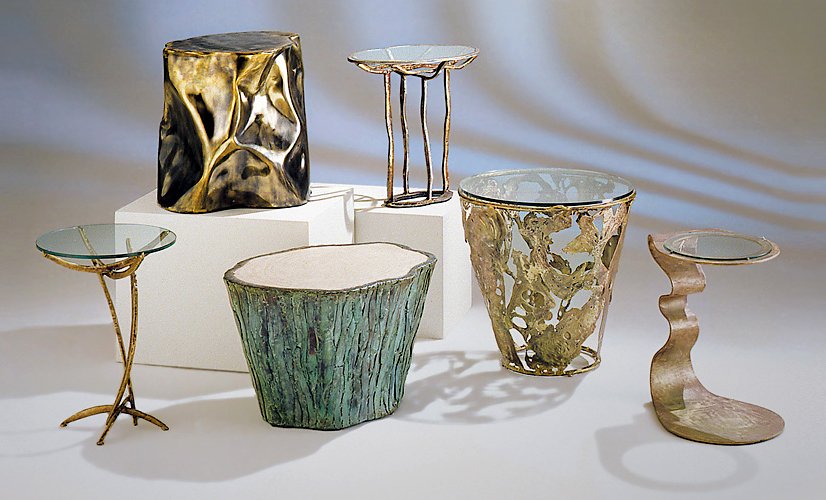 |
A selection of end tables by Silas Seandel, showing his limitless creativity. Pieces are on view at the artist’s showroom and all can be customized. Clockwise: Tree Trunk, Rib, Bronze Filigree, Loupe, Stone Top Tree Trunk and Ortago. |
 | |
Silas Seandel |
“Everyone is an artist, everyone can create a piece of work, when there are no limitations. When it comes to sculpted furniture it’s a whole different ball game, there are limitations — not only does it need to have aesthetic appeal, but it has to have functionality and make sense. There’s a tremendous amount of engineering that comes along with making sculptured furniture. It is enormously complex to design sculpted furniture that actually works!” — Silas Seandel
At 82, Silas Seandel begins each day as he has for the past 41 years, opening the door to his studio to start another day of designing and fabricating his sculptural furniture that has, from the beginning, been recognized and prized for its distinctive sensuous appeal. He has worked at this location in Chelsea since 1978, when it was a gritty area filled with warehouses and auto body shops, rather than the chic neighborhood it is today. Much has changed, but the drive to express himself through his art is undiminished — it is the very core of his identity. Seandel is a pioneer; one of the first to utilize sculptural techniques in the creation of furniture, elevating the utilitarian to collectible art. All of his pieces are handmade in the studio of solid metals such as brass, bronze, steel, aluminum and copper. As a purist, Silas finds satisfaction in manipulating raw materials, and through years of experimentation, he has developed custom finishes created solely with acid and heat — no enamels or veneers. His personal favorites, he says, are the torch-cut Brutalist tables and sculptures that require a delicate balance of discipline and spontaneity. Inspired by the process itself, he muses, “I love to see molten metal flow.”
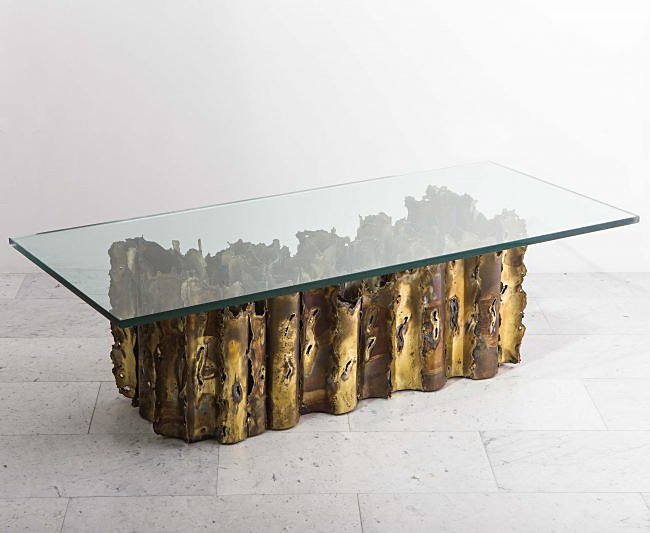 |  | |
Cathedral Table, circa 1975, by Silas Seandel. Brutalist-style torch-cut pieces are the artist’s favorites. Photos courtesy Todd Merrill Studio | ||
Born in Brooklyn in 1937, Silas’s path to becoming a sculptor was circuitous. After a stint in the service, he graduated in 1959 with a degree in economics from the University of Pennsylvania, but had no passion for a life of numbers-crunching. There were subtle hints of what was to come — he had a propensity to tinker; he liked to work with his hands. He had taken clay modeling classes in college, made little mobiles and models for fun, and was drawn to the work of Calder, who was gaining worldwide prominence during that time. Seandel’s aha moment came very unexpectedly in 1963, when a chance visit to an exhibition of 1950s metal sculpture at the Walter P. Chrysler Museum in Provincetown exposed him to works by Richard Stankiewicz, John Chamberlain and Jason Seley. The exhibit was a revelation, and from there, his course was set. In his typical direct and independent fashion, he proceeded to teach himself welding from a book. He experimented with tin cans, making many mistakes along the way, and spent every spare moment working in metal, honing his technique. All the while, he supported himself working menial jobs — bagging groceries, working as a stock clerk at B. Altman & Co. When Altman’s interior decoration department was contracted to redecorate a country club, the designer in charge asked Silas to create a wall sculpture. The piece was seen and very well received by other decorators, and commissions began to roll in. Next, with borrowed money, he rented a showroom in the D&D building to display his work, bringing in orders from decorators and high-end stores including Neiman Marcus and Gump’s. His hugely popular but much-imitated wall sculptures led him to create his unique sculptural furniture, and a number of substantial public sculpture commissions followed. A recent notable example: a fifteen-foot-tall stainless steel and bronze 9/11 memorial piece for the grounds of Greenwich Hospital in Connecticut.
 | 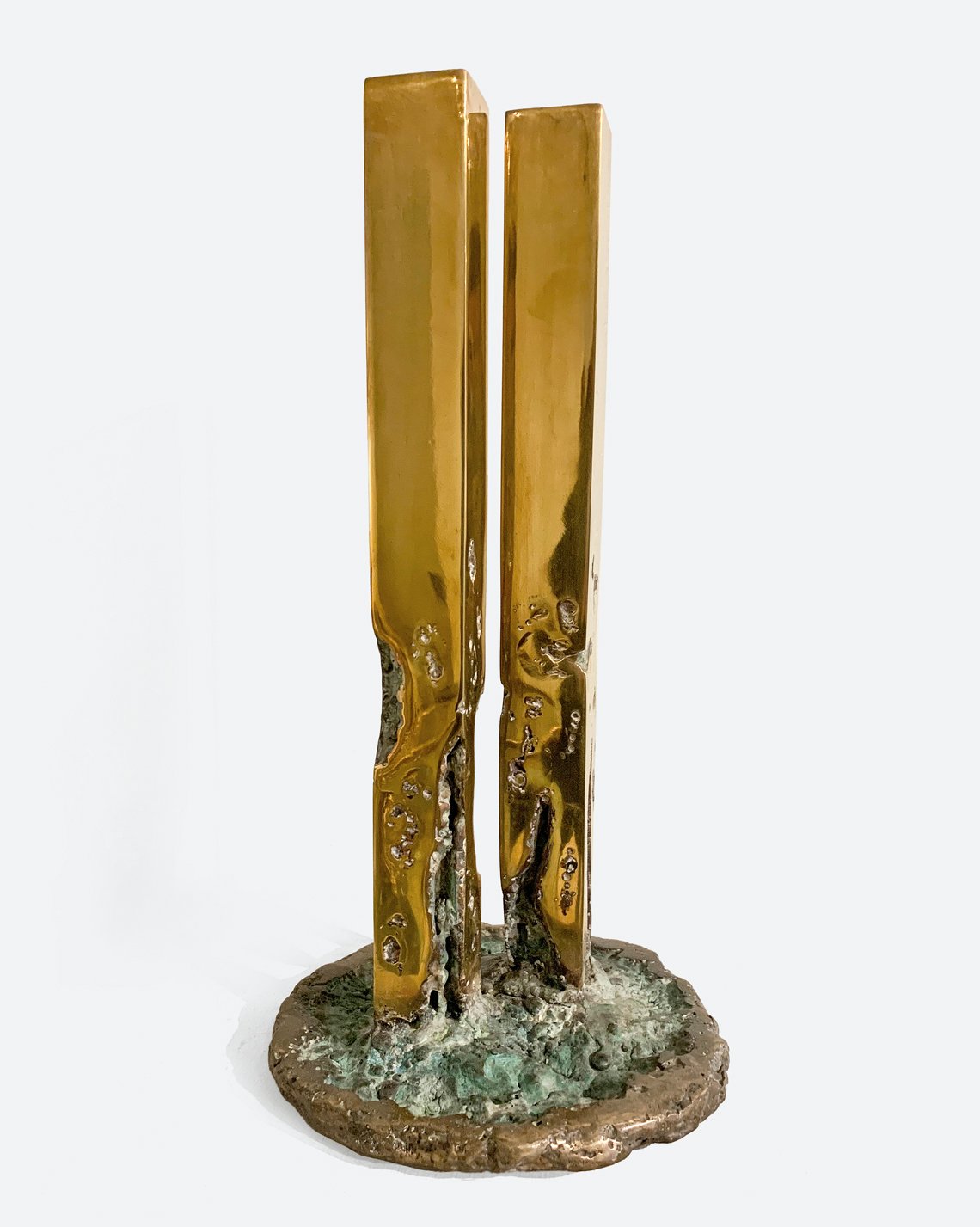 | |
| Left: Silas in his showroom, where pieces are on view, available to order and also to serve as inspiration for custom work. Right: A model of the 9/11 monument Seandel created for Greenwich Hospital. | ||
 |
 | |
David Scott |
Silas is happy to chat about his beginnings, but as a creator, has his sights set on the future. From then to now, his welding torch has scarcely had a moment to cool down, and these days he is busy with custom commissions, collaborating with architects and interior designers. We spoke with Interior designers Amy Lau and David Scott about their experiences with Silas creating one-of-a-kind pieces for their clients:
“Working with Silas recently on a 10-foot-high decorative screen we commissioned for a residence overlooking the UN was an incredible experience. He poured beautiful bronze organic “melted” forms and then set several pieces of polished agate that we had sourced like smooth natural jewels in the landscape he created. Silas approaches each commission as the true artist he is and he really enjoys making useful and functional art.” — David Scott
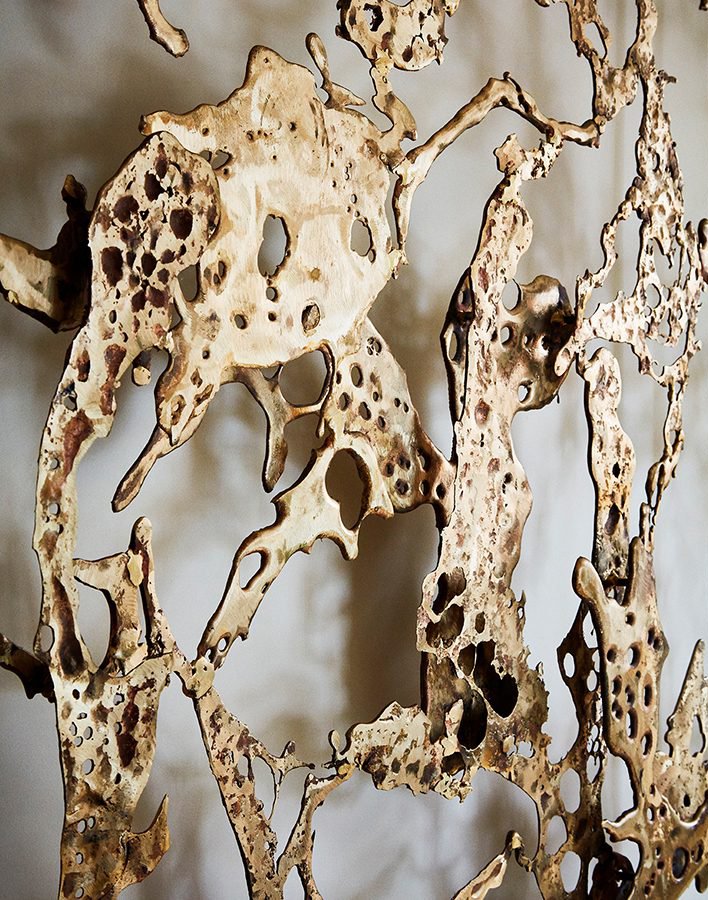 |  | |
Amy Lau commissioned Silas to create a custom cast bronze screen for the East End Avenue residence of her longtime clients. A piece of sculpture that functions as a room divider, it defines the living room and dining room as separate areas without interrupting the flow of light through the space. Photos courtesy Amy Lau Design | ||
 | |
Amy Lau |
Did you provide a preliminary sketch, or did you develop the idea in his studio with him?
One of the greatest challenges for this space was devising an elegant way to divide the living and dining areas, making them distinctively different, while maintaining the lightness and airiness of the space. I love the work of Silas Seandel, so together we came up with the concept of a three panel screen made from layers of cast bronze. This particular screen is a variation of a design that Silas had played with previously, so we initially worked together on a conceptual model, 20” high x 24” wide, which we presented to the client before developing the full size piece we eventually installed. We felt it was the best way to present the concept to the client. The effect we desired was one of Jackson Pollack-like gestural paint splashes layered on top of one another in bronze, two layers in some places, one in others, which you can see in the maquette.
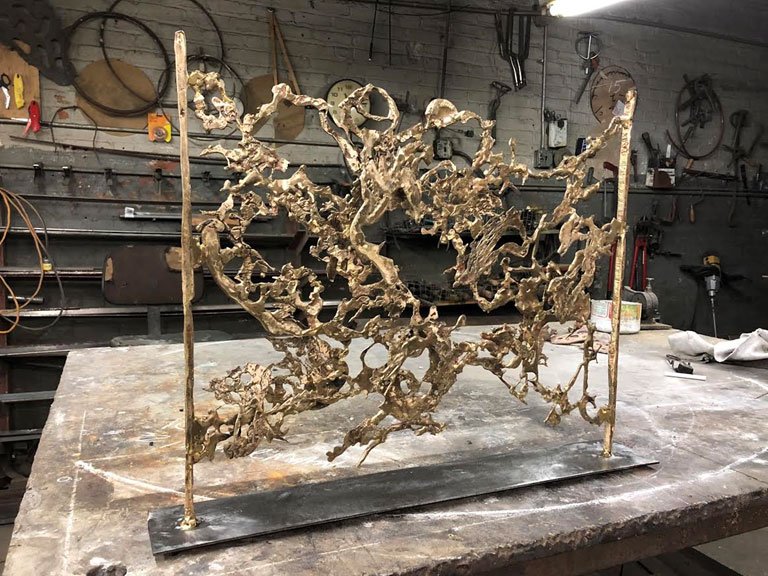 |
A maquette created by Silas for Amy Lau, which she then presented to her clients for approval. |
Approximately how long was the process from final concept to finished piece?
From our initial concept discussion through installation, I would say the process was almost one year.
Did you make any revisions to the piece?
This is a very organic piece within the height that we had to work with, so there were many studio visits where I would look at how the bronze layers were applied. We also fooled around with the sizes of the bronze pieces, and we spent a lot of time on how smooth or rough the frame would be, ensuring that the frame complemented the bronze pieces.
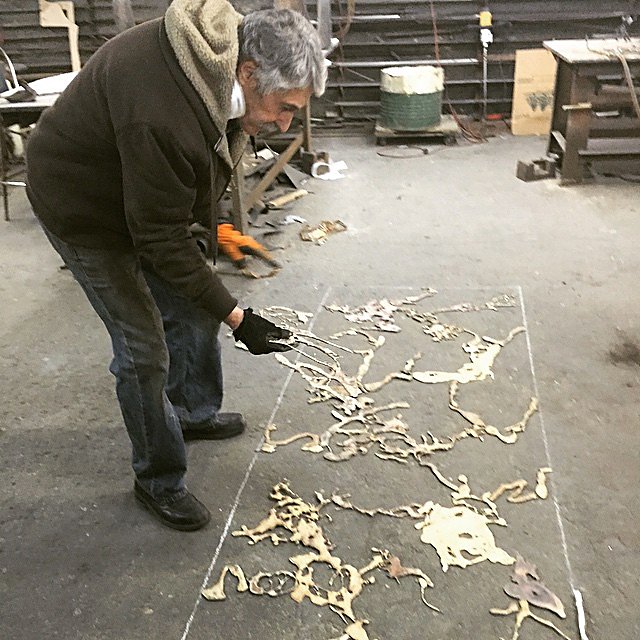 |  | |
Left: Silas in the studio at work on the screen, collaborating with Amy, who took these photos. Right: A detail of some free-form cast bronze components for the screen. The concept was to create a Jackson Pollack-like effect, with layers of bronze “splashes.” Photos courtesy Amy Lau Design | ||
Tell us about your experience working with him.
Silas has such a wonderful studio; he is extremely hands on and very welcoming. My clients and I visited while he was pouring part of the screen, which was a very personal experience for my clients to participate in.
I used to drive Silas crazy for being so persistent in my desire to go through his archival material, carefully studying each and every one of the maquettes he had created over the years, along with poring over magazines and catalogs in which he was featured.
 |
We recently visited Silas in his studio, and he shared his insights on inspiration, the mental and physical steps in his design process, and what he does when he’s not working.
Tell us about your design process — where do you draw your inspiration from? Who are your influences?
I love nature, and I love texture. I have always been drawn to different materials: rough stone, sand and clay, along with metals. Rough and rugged, vs smooth and shiny, I like the contrast of the materials very much and the juxtaposition of them together.
Favorite sculptors are Lynn Chadwick, Henry Moore, James Wines, Herbert Ferber, Richard Stankiewicz. All of these artists mixed media or utilized it in ways that I had never seen before: experimental finishes, putting bronze on bronze, overlaying smooth bronze with rough melted bronze. They were groundbreaking and doing work that was cutting edge and never seen before.
 |
| "Volcano" and "Twigs" occasional tables in cast bronze can be customized to size and finish. |
Do you start your designs with a form in mind or do you start with the material you would like to work in and go from there?
I start with a form. In my mind, I have a warehouse full of Rolodexes, one Rolodex is texture, one Rolodex is malleability, one Rolodex is ability to execute, another is physical limitations — the weight, the size. Once I get the image in my mind, all of these Rolodexes start moving and I start to imagine what meshes with what. When I get a match in my mind, I begin with a sketch on paper, then create a maquette, and finally I build the piece. So it’s mind, to paper, to maquette, to final creation.
 |  | |
Left: The Amy Console, named after interior designer Amy Lau. The bronze “splashes” are meant to evoke the paintings of Jackson Pollock. The style element is adaptable to a variety of pieces and has been fashioned into room screens, table bases, console bases, and wall sculptures. Right: The Terra Table, of cast stone with veins of bronze and bronze base. Resembling a slice of rock with fingers of ore running through it, the inspiration came to Silas over a decade ago, but perfecting the cast stone process took years of experimentation. | ||
How important is a maquette in your design process?
A maquette is extremely critical to the process. The maquette is generally made in the same material as the final product and very often that’s the stage at which I decide if I want to go ahead with the piece. The maquette for an original design is the roadmap to the process, it’s the basis of everything.
When you create a custom piece, how is the client involved in the creative process and what is their role?
If a client comes to my gallery and looks over all of my pieces that are already made, and while looking around, they see a line, a curve, a color or a texture that they like from several different pieces, very often using that input I will design a piece for them based on the elements that they love. That is mostly how a fully new commission will come to be. In some cases we will go over the maquette to make changes, but for the most part my clients let me run with my ideas based on my reputation and skill level.
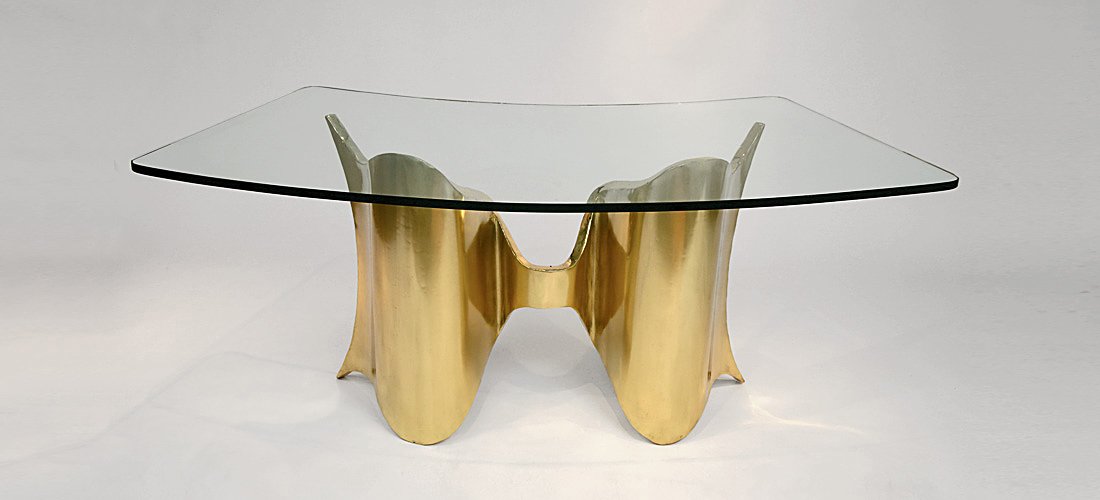 |
| The free-flowing and sensuous Miro Dining Table, shown here with a curved glass top for use as a desk, in statuary bronze with subtle polychrome patinas. |
Tell us something that the design world might not know about you.
I’m always working and I always have been. I am here pretty much all the time, but I do like to spend time fishing and playing table tennis.
As a New York artist, tell us how the city influences your work?
I love NYC because of its resources, everything I need is here. The main influence has been the ease of obtaining materials, freeing time for the creative process. I used to drive all over the city to pick up materials and now they are delivered to the studio. One thing I really don’t miss is unloading steel and welding tanks off the trucks.
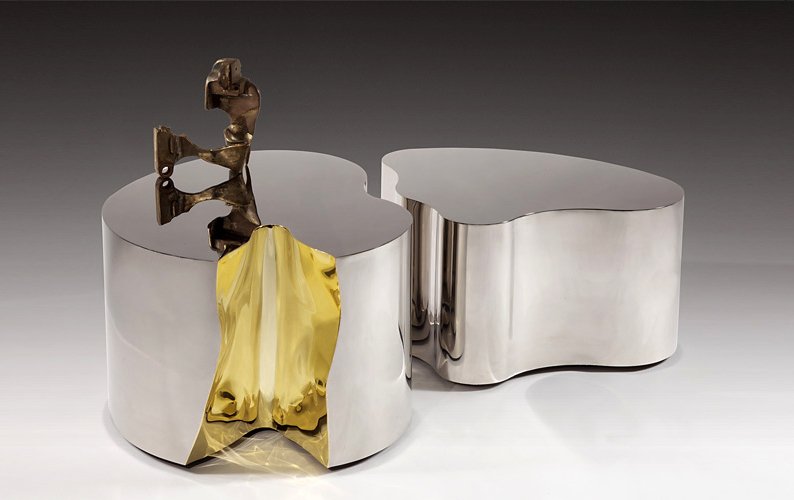 |
“Bronzeforms 4 SV” cocktail tables in mirror finish stainless steel with a mirror finish brass insert. The two biomorphic sections fit together as one unit or can be separated as shown. The pieces vary in height, with one piece 4 inches taller than the other. |
What materials do you find the most challenging to work with and why?
All materials have their challenges in some way or another and have limitations. I just try to work within those parameters. I love working with “mild steel” which is the most common steel used in bridges and structure and machinery — commonplace objects. I love that my work has strength visually and physically because of these materials.
What about your work makes it so identifiable as a Silas Seandel piece? What would you say is your signature element in each piece?
I don't have a signature element! Every piece is always unique, no one makes furniture that looks like mine, it’s all original to what I dream up. The inspiration that fuels my creativity is limitless, so the shapes are different, the combination of materials, the finishes, the colors, the texture.
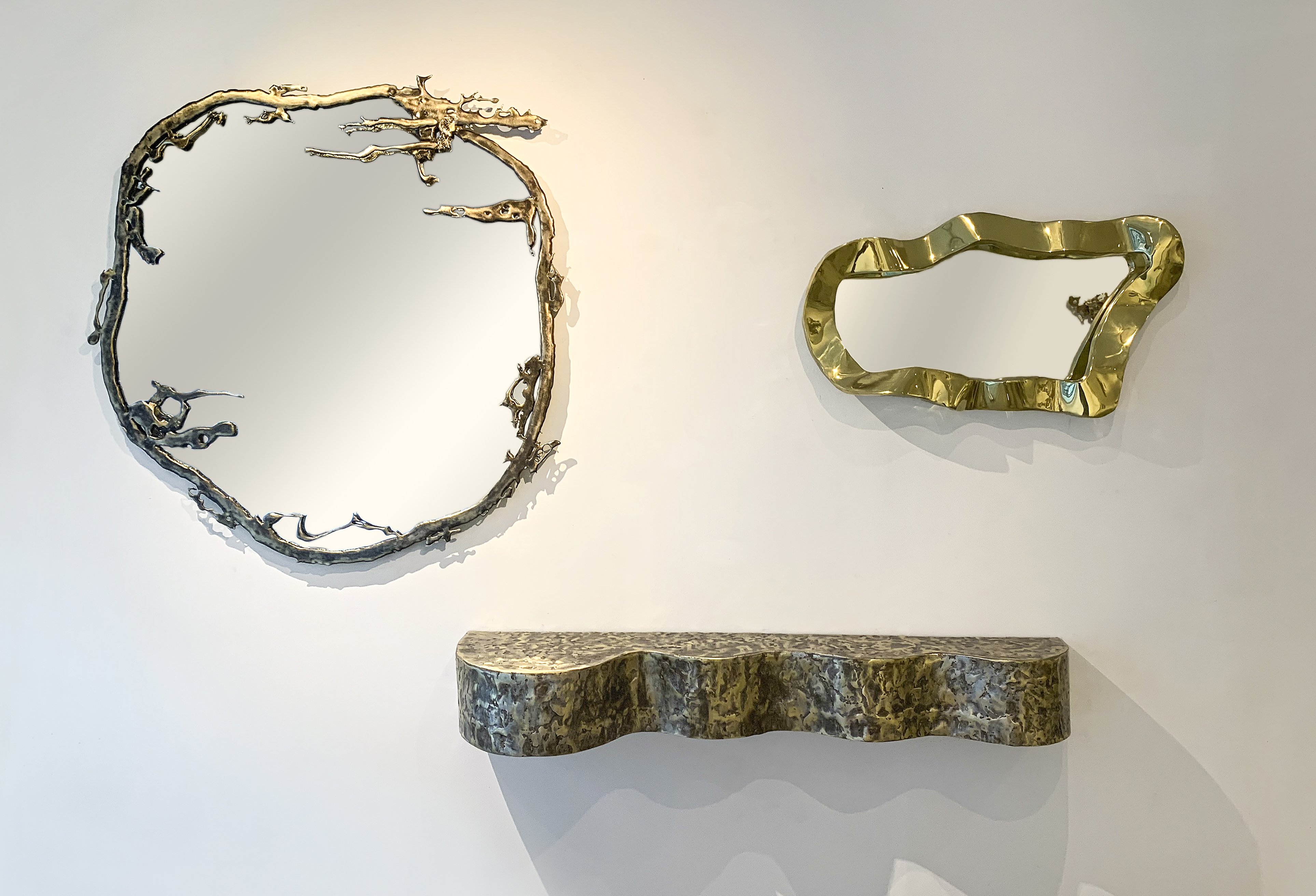 |
| In the showroom, a selection of mirrors and a shelf show a few of the wide range of textures and finishes Silas has created. |
 |
Do you sign all of your pieces? If a piece isn’t signed, is there a specific reason?
I didn’t early on, just out of indifference, I have never been concerned with legacy, I just loved doing the work and creating, so in my earlier pieces I didn’t think to sign everything. Now I sign my pieces because I realize that clients value having my signature on the work.
What in your career are you most proud of?
I didn’t start off making furniture, I started making wall sculpture pieces in the early 60s, but when I found out that these were being copied, I decided to make sculpted tables. You can’t just copy a piece of furniture, it’s much more complicated because it has to be structurally sound, with balance and proportions perfect. The first table that I made was so successful that I just knew this new approach to sculpture was going to prove to be the turning point of my career. That first piece was called The Dimension Cocktail Table.
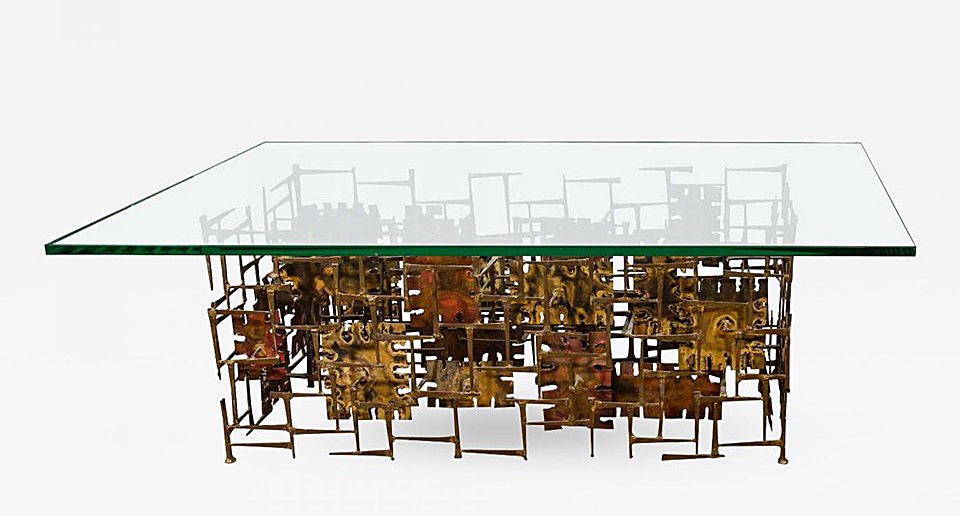 |
The piece that started it all: The Dimension Cocktail Table |
At 82, with an incredibly impressive body of work and nonstop creativity, what's next? What's your goal for the immediate future?
My energy level has faded a bit, but I’m pleased that I’m still coming up with new ideas and I continue to do so. I still get a “rush” from the creative process — the excitement of seeing it come to fruition.
 |




























